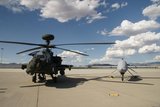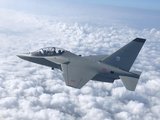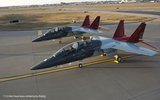I/ITSEC 2022: HII enhances human-machine teaming training for US Army
HII’s crewed-uncrewed teaming training system has been tested with the US Army’s Apache, but it can operate with any autonomous system with the right equipment to receive data.
Although DRTS will be supported, the system will eventually be replaced by LTRaC. (Photo: US DoD)
The US Army’s PEO STRI has used I/ITSEC to provide industry with a briefing on its future requirements. This was a useful update to that given at the Training and Simulation Industry Symposium (TSIS) delivered this June in Orlando.
Yet again, the first thing to strike non-US attendees was the openness and willingness of the military to engage with industry. As programme managers introduced their specific departments, they showed an organigram of section heads and provided telephone and contact details for project managers. This level of transparency is seldom seen outside the US and the services must be applauded for this approach.
PEO STRI comprises five programme offices: Synthetic Environments (PM SE); Soldier Training (PM ST); Cyber Test & Training (PM CT2); Training Aids, Devices, Simulators & Simulations Support Operations (PL TSO); and the International Program Office (PL IPO).
I/ITSEC 2022: How the US Marine Corps' future vision will impact the training & simulation industry
Naval aviation commanders spotlight future training strategy at I/ITSEC 2022

Karen Saunders leads Orlando-based PEO STRI. (Photo: NDIA)
Col Cory Berg, Project Manager ST, is responsible for virtual, live, combat training instrumentation, combat training centres (CTC) and future training systems.
‘As well as working closely with our industry partners, we’re also working hard to reach out to equipment offices to explain to them what training opportunities and solutions are available,’ said Berg.
As well as new equipment and systems entering service, Berg made the point that PEO STRI must support older equipment such as the M1 Abrams and M2 Bradley. This sustainability challenge was also raised by the Project Lead IPO, Dale Whittaker when referring to older hardware being supplied to ‘our allies and partners through the IPO’.
Whittaker also highlighted the issue of ‘interoperability with partners in areas such as CTCs,’ as ‘we will be working closely with these partners in the future,’ and so we need industry to help us achieve that.
PM ST briefed the audience on 11 major programmes, the most significant of which included: STE (the US Army’s major Synthetic Training Environment requirement); CTC and Home Station Aviation Force-on-Force (CHAF) training; Digital Range Training System (DRTS) Continuous Tech Refresh Tiers 1 and 2 as well as the eventual DRTS replacement, the Live Targetry, Ranges and CTCs (LTRaC) programme.
LTRaC is valued at over $900 million. ‘This will be a full and open, ID/IQ programme that includes multiple lots, including a small business lot,’ explained Berg.
Other programmes discussed by PM ST were the Soldier Virtual Trainer (SVT); the Mobile Protected Firepower (MPF) Precision Gunnery Trainer; and a number of maintenance trainers as well as STE Live Training Systems.
One challenge faced by PEO STRI is the integration of the new STE architecture with legacy and new systems entering service. In many ways that challenge is also reflected in the UK with its Collective Training Transformation Programme (CTTP). Exciting times are ahead.
Shephard's I/ITSEC 2022 coverage is sponsored by:


HII’s crewed-uncrewed teaming training system has been tested with the US Army’s Apache, but it can operate with any autonomous system with the right equipment to receive data.

The Shephard Media news team looks at all the developments in the military training and simulation world, and discovers the trends and challenges in seabed warfare.

Leonardo is developing the Smart Chair system in its Battle Lab that allows for advanced pilot training for multi-domain scenarios and can potentially 'replicate a sixth-generation fighter jet cockpit'.

Boeing's T-7A Red Hawk simulator and maintenance training system will allow pilots and ground crew to train in novel ways as soon as the platforms are delivered.

Saab has increased training activities across core markets, opened combined training centres and is set to grow its business further.

CAE believes the future of training technologies will be fundamentally driven by bringing different industries together and no single company can exist in a vacuum - an approach that defence should adopt too.